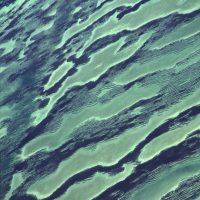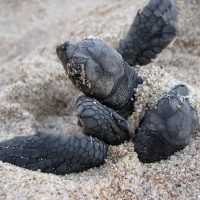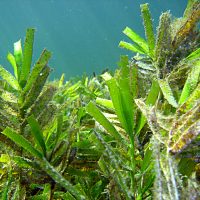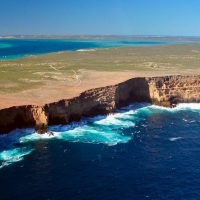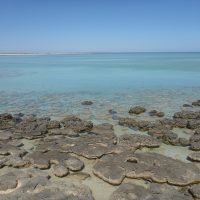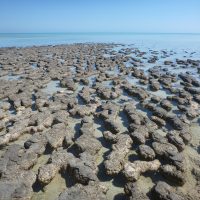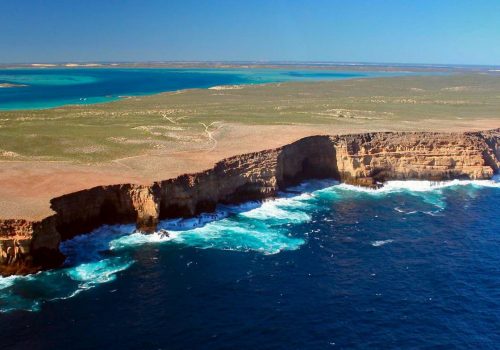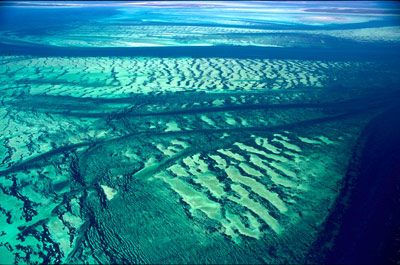Shark Bay World Heritage Values
The stromatolites of Hamelin Pool are examples of superlative natural phenomena. They are one of the world’s best examples of a living analogue for the study of the nature and evolution of the Earth’s biosphere up until the early Cambrian.
The sheltered coves and lush seagrass beds of Shark Bay are a haven for animals such as the green turtle; one of the world’s largest dugong populations; and migrating humpback whales. It is one of Australia’s most important nesting areas for the endangered loggerhead turtle.
Shark Bay is one of the few marine areas in the world dominated by carbonates not associated with reef-building corals. This has led to the development of the Wooramel Seagrass Bank which covers 103,000 hectares, the largest seagrass bank in the world. With 12 species of seagrass, Shark Bay also has the greatest diversity of seagrasses in one area.
The evolution of Shark Bay’s hydrological system and hypersaline environment of Hamelin Pool are of great significance. A steep salinity gradient creates three biotic zones affecting the distribution and abundance of marine organisms.
The biological processes of ongoing speciation, succession and creation of refugia are also important. Shark Bay provides refuge for numerous rare and threatened terrestrial plants and animals. Islands of Shark Bay are the last stronghold for five critically endangered mammals, four of which occur naturally in the wild nowhere else on Earth.
Superlative natural phenomena or areas of exceptional natural beauty and aesthetic importance
Shark Bay contains unique, rare and superlative natural phenomena and formations and features of exceptional natural beauty, including:
- Hamelin Pool, the only place in the world with a range of stromatolite forms comparable to the fossil record
- Wooramel Seagrass Bank, part of one of the few marine areas dominated by carbonates and also the largest seagrass meadow in the world
- a diversity of landscapes formed by aridity – peninsulas, islands and bays
- exceptional coastal scenery at Zuytdorp Cliffs, Dirk Hartog Island, Peron Peninsula, Heirisson and Bellefin Prongs
- wide sweeping beaches of shells at Lharidon Bight
- great natural beauty of inundated birridas such as Big Lagoon
- strongly contrasting colours of Peron Peninsula dunes and cliffs
- abundance of marine fauna – dugongs, dolphins, sharks, rays, turtles and fish
- extensive annual wildflower displays associated with rich flora.
Outstanding examples representing major stages of earth’s history, including the record of life, significant on-going geological processes in the development of landforms, or significant geomorphic or physiographic features.
Shark Bay contains the world’s most diverse and abundant examples of stromatolitic microbialites in one place. These are analogous to structures that were the dominant benthic ecosystems on Earth for 3,000 million years.
The Wooramel Seagrass Bank is of great geological interest due to extensive deposits of limestone sands formed by the precipitation of calcium carbonate. The hypersaline environments of Hamelin Pool and L’haridon Bight environment are created by seagrass banks.
Outstanding examples representing significant on-going ecological and biological processes in the evolution and development of terrestrial, fresh water, coastal and marine ecosystems and communities of plants and animals
Shark Bay provides outstanding examples of processes of biological and geomorphic evolution. These include evolution of Shark Bay’s hydrologic system; the hypersaline environment of Hamelin Pool; and biological processes of ongoing speciation, succession and creation of refugia. Shark Bay has:
- steep salinity gradients due to development of banks and sills such as Faure Sill
- three zones of differing salinity levels – oceanic, metahaline and hypersaline
- three distinct biotic zones caused by salinity gradients
- Hamelin Pool, a landlocked marine basin forming a reversed estuary containing hypersaline waters
- restricted communities of marine organisms that have developed physiological adaptations to tolerate hypersaline conditions including the bivalve Fragum erugatum
- vast, rare and scientifically important deposits of Fragum erugatum shells; coquina; ooid shoals; lithified sediments; broad supratidal flats with evolution of subsurface evaporitic deposits; and meromictic blue ponds
- modification of the physical environment caused by vast seagrass meadows as they build banks and sills and influence water currents
- carbonate deposits and sediments – Wooramel Seagrass Bank
- Holocene deposits adjacent to Hamelin Pool and L’haridon Bight; and evidence of ooid formation, submarine lithification and micritisation
- great genetic variability in marine species – pink snapper, venerid clams
- stromatolites and benthic microbial communities
- high species diversity and high density of bivalves
- seagrass-based ecosystems – nutrient cycling, food chain, nursery grounds, habitat variety, and creation of steady-state hydrological conditions
- the largest seagrass meadows in the world
- highly species-rich assemblage of seagrasses
- isolation of fauna habitats on islands and peninsulas
- isolated populations of rufous hare-wallaby and banded hare-wallaby demonstrating evolutionary processes
- transition zone between temperate and tropical marine ecological provinces and resulting high species diversity – 323 fish spp; 218 bivalve spp; 80 coral spp
- transition zone between the Southwestern Botanical Province dominated by Eucalyptus species and the Eremean Province dominated by Acacia species including:
– 145 known plant species at their northern limit in Shark Bay
– 39 known plant species at their southern limit in Shark Bay
– 28 known endemic vascular plant species
– vegetation of the southern Nanga and Tamala areas containing a pronounced overlap between botanical provinces - the northern end of range for numerous southern faunal species including known species of reptiles, amphibians and birds
- coastal end of range for arid-interior species, including numerous known species of frogs, geckos, skinks and monitors
- examples of ‘gigantism’ in tree heath vegetation south of the Freycinet Estuary; and the diversity of plant and animal species including an estimated 35% of Australia’s total bird species.
Containing the most important and significant natural habitats for in-situ conservation of biological diversity, including those containing threatened species of outstanding universal value from the point of view of science or conservation
Shark Bay contains important and significant natural habitats where species of plants and animals of outstanding universal science and conservation values still survive. It contains habitats for, and species of, conservation significance:
- at least 28 endemic vascular plant species, 11 of which occur on Tamala Sandplain and coastal zone
- new plant species and expanded ranges for known species
- the only populations or major populations of the burrowing bettong (Bettongia lesueur), rufous hare-wallaby (Lagorchestes hirsutus), banded hare-wallaby (Lagostrophus fasciatus); Shark Bay mouse (Pseudomys fieldii), and western barred bandicoot (Perameles bougainville)
- an estimated one eighth of the world’s dugong (Dugong dugon) population
- large numbers of visiting humpback whales (Megaptera novaeangliae) during their annual migrations
- green turtle (Chelonia mydas) and loggerhead turtle (Caretta caretta)
- nine known endemic reptile species

